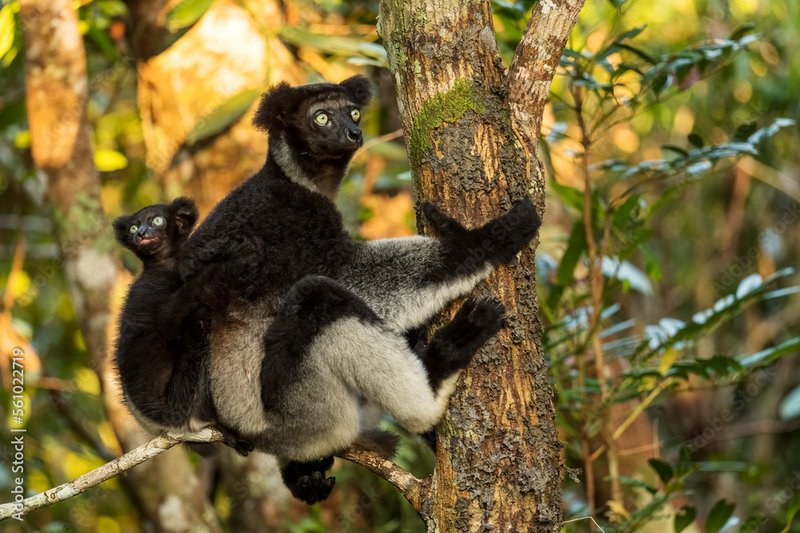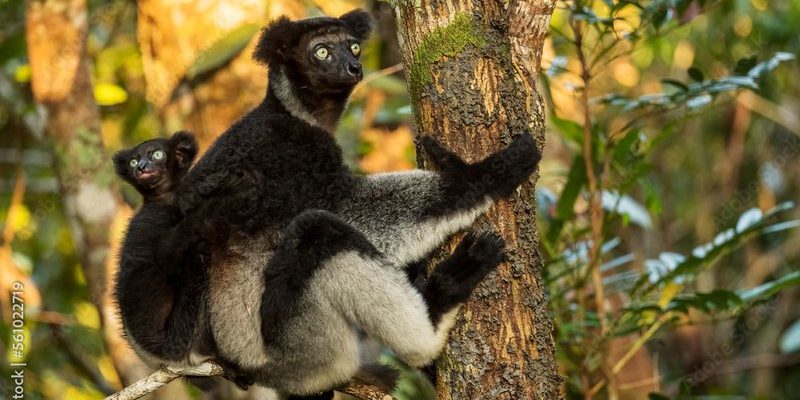
Understanding the Indri is like piecing together a puzzle that spans time and geography. This primate isn’t just a quirky animal with a loud voice; it’s an example of how species can evolve in unique ways when separated from their relatives. Let me explain how the Indri’s journey unfolds through the ages, revealing insights into its adaptations, relationships with other lemurs, and the conservation challenges it faces today.
What Is the Indri?
The Indri (Indri indri) is the largest living lemur in the world. If you visited Madagascar, you might catch a glimpse of this intriguing creature leaping gracefully between trees, with its long limbs and distinctive tail. One of the most striking features of the Indri is its vocalization, which can be heard from miles away. Their calls are not only beautiful but crucial for communication within their family groups.
These lemurs are primarily arboreal, meaning they spend most of their lives in the trees. They have adapted to their environment in ways that enhance their survival. Their diet mostly consists of leaves, fruits, and flowers. This specialized diet reflects how they’ve evolved to thrive in Madagascar’s unique ecosystem, which is filled with diverse plant life.
Here’s the thing about the Indri: they can’t be found anywhere else in the world! Their entire existence hinges on the specific habitat of Madagascar. This island’s long isolation from the mainland has resulted in the Indri developing unique traits compared to other primates.
A Glimpse into Lemur Evolution
To understand the Indri, we must look at its evolutionary background. Lemurs are a branch of primates that evolved in Madagascar after the island split from the African continent. This isolation allowed lemurs to diversify into various species, each developing unique adaptations to their environment.
The Indri’s ancestors diverged from other lemurs around 30 million years ago. They share a common ancestor with the other lemurs, but as time went on, different species evolved distinct traits and behaviors suited to their specific habitats. The Indri’s unique adaptations, such as their climbing abilities and social structures, showcase how evolution can shape a species over millions of years.
Interestingly, the Indri is most closely related to the Sifaka, another type of lemur. Both belong to a group known as the *lemuriforms*. However, despite their similarities, they’ve adapted to their own niches within the island, further demonstrating how species can evolve both together and independently.
Adaptations that Define the Indri
One of the most remarkable aspects of the Indri is its physical adaptations. These primates have incredibly strong limbs, which allow them to leap from tree to tree with impressive agility. You might be wondering how far they can jump—well, they can leap over ten meters in a single bound! This ability is crucial for navigating the treetops where they live.
Additionally, Indris have long, flexible limbs that help them climb and maneuver through their forest homes. Their powerful legs and large feet enable them to grasp branches firmly, which is vital for maintaining balance as they leap and move.
Another cool adaptation is their vocalization. The Indri communicates using loud, complex calls that can resonate through the dense foliage. These calls play a significant role in maintaining social bonds and marking territory. It’s like their way of saying, “Hey, this is our space!” Their vocalizations are so distinct that researchers can identify family groups based on the sounds they make.
The Role of the Indri in Ecosystems
The Indri plays a vital role in Madagascar’s ecosystem. As they munch on leaves and fruits, they help disperse seeds, contributing to the growth of various plant species. This interaction is a classic example of mutualism, where both the Indri and the plants benefit from one another.
By maintaining healthy forests, Indris support other wildlife that depends on the same environment. Their presence is crucial in preserving the balance of their ecosystem, showcasing how interconnected nature can be. Imagine these lemurs as the gardeners of their forest, helping grow new life while ensuring their own survival.
However, this delicate balance is under threat due to habitat destruction. Deforestation and human encroachment are making it increasingly difficult for Indris to thrive, leading to concerns about their population status. Conservation efforts are crucial to ensure these fascinating creatures continue to play their role in Madagascar’s biodiversity.
Threats to the Indri’s Survival
Despite their unique adaptations and crucial role in the ecosystem, the Indri faces significant threats. The primary issue is habitat loss caused by deforestation, mainly due to agriculture and logging. This loss not only reduces their living space but also disrupts their food supply.
The Indri’s low reproductive rate compounds this problem. Females typically give birth to only one offspring every two to three years. This slow breeding means that populations can struggle to recover from declines, making every individual count. If their habitats continue to shrink, we risk losing not just the Indri, but a vital piece of Madagascar’s ecological puzzle.
Conservation organizations are actively working to protect the Indri and its habitat. Initiatives focused on sustainable land practices, raising awareness, and restoring forests are fundamental for the survival of these magnificent creatures. It’s essential that visitors to Madagascar understand the importance of preserving this unique biodiversity.
Conservation Efforts and Future Outlook
The future of the Indri depends significantly on ongoing conservation efforts. Local and international organizations are working tirelessly to protect these lemurs and their forest homes. For example, reforestation projects aim to restore areas that have been degraded while community education initiatives encourage local people to appreciate and protect their natural heritage.
You might find it inspiring that eco-tourism is also helping with conservation. By promoting sustainable travel methods, visitors can contribute to the economy while fostering a greater appreciation for the natural world. When people see the Indri, hear its distinct calls, and learn about its role in the ecosystem, they often become advocates for conservation.
Ultimately, every bit of effort helps. The Indri serves as a symbol of Madagascar’s unique wildlife and the importance of biodiversity. It reminds us that protecting one species can have a ripple effect on preserving an entire ecosystem.
The story of the Indri is a fascinating tale of evolution, adaptation, and the intricate relationships that bind species to their environment. From its unique physical features to its critical role in the forest ecosystem, the Indri showcases the beauty of biodiversity and the need for conservation. While challenges remain, ongoing efforts to protect this remarkable lemur bring hope for its future. As we learn more about the Indri and its place in the grand tapestry of life, we are reminded of our responsibility to safeguard the natural world for generations to come.

